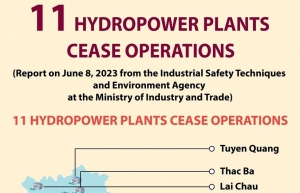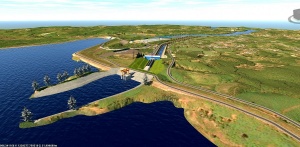The unseen risks of hydropower on the Mekong’s economic fabric
 |
This short-term focus neglects hydropower’s negative impacts on the region’s broader long-term economy, specifically the growing risks that hydropower is creating in the Mekong Delta – the regional heart of the manufacturing economy.
The commonly debated trade-off between the value of electricity and the impact on people's livelihoods merely scratches the surface; it's time to scrutinise the broader economic, societal, and environmental implications, especially for key economic sectors such as apparel, sand, electronics, fisheries, aquaculture, and rice.
Not only are these large and growing parts of the economy, they are also heavily dependent on a healthy Mekong River, a state that is being threatened by ongoing hydropower development.
In many ways, this is a simple economic equation. Hydropower proponents are emphasising its benefits while ignoring the potential impacts on exports and food production. To put this into context, the $6 billion investment in hydropower in the region, while significant, pales in comparison to the $260 billion tied to textiles and electronics exports in Vietnam, Cambodia, and Laos.
Moreover, while hydropower investment is level or shrinking, the manufacturing sector continues to grow significantly in the region. Therefore, it is important to question whether the trade-offs we accept for the relatively small hydropower sector are worth jeopardising much larger industries and essential supply chains. We are running the risk of a minimal increase in energy supply that hobbles water-dependent industries downstream. We need a more balanced approach.
While some forms of hydropower can benefit people and nature when systematically planned within a broader sustainable energy strategy, maximising large-scale hydropower threatens future economic growth in key downstream sectors.
Hydropower development in the Lower Mekong threatens the region's hydrological, ecological, and socioeconomic systems through alterations to the natural flow regime, disruptions in fish breeding cycles, the isolation of floodplains, reduced sediment transport, and uncertain power generation during exceptionally dry years. It also amplifies the risk of floods and droughts, and disrupts water access and supply chains.
These impacts create ripple effects across society. For example, a loss of fish and a reduction in the productivity of flood-based farming drives up food costs and inflation, and in turn, wages – a significant obstacle when attracting the manufacturing sector to Mekong countries.
Similarly, reduced sediment decreases soil fertility and can increase coastal flooding, while dam releases create uncertainty for farmers and can also exacerbate riverine flooding, which can interrupt supply chains and devastate industry – the Thai government estimated the economic loss caused by flooding in Bangkok in 2011 at $42.2 billion.
If companies deem these regions to hold high risks of interruption or growing costs, they will shift elsewhere. This means the potential loss of jobs, taxes, and other benefits from key growth sectors such as apparel and electronics, as well as regionally important areas for food production. This emergent hydropower-driven risk should be a clear warning to all countries in the Mekong Basin.
A recent WWF report titled Risk or Reward: Hydropower Impacts on Supply Chains in the Lower Mekong Basin systematically examines five types of risks – physical, market, financial, regulatory, and reputational – for five key regional supply chains, namely energy production, fisheries and aquaculture, rice production, sand and construction, textiles, and electronics, exposing significant vulnerabilities.
Certain risks to fisheries and food security in the Lower Mekong have been widely acknowledged by riparian governments, however, the full extent of these threats remains underestimated. Fisheries and aquaculture in the region face substantial physical, financial, and market risks, potentially resulting in $21 billion in losses.
Other sectors, such as electronics and textiles, receive limited attention despite their vulnerability due to the operation of hydropower plants, posing cascading financial, regulatory, and reputational challenges for factories operating in high-exposure areas like the Mekong Delta.
The highest risks associated with hydropower development are particularly acute for the Lower Mekong Basin countries – Cambodia and Vietnam – where the interconnected threats to ecosystems, food security, and industries are most pronounced. However, these consequences extend much further, resonating across global supply chains and impacting countries that depend on a stable and productive Mekong region.
Recent advancements underscore the potential to fulfill global climate and energy goals without jeopardising industries, ecosystems, and biodiversity by compromising our remaining free-flowing rivers. This signals a pivotal moment where the judicious application of the right renewables in the right locations can redefine our energy landscape sustainably.
It's time for policymakers and businesses to recognise the broader implications and incorporate these considerations into their risk assessments. A comprehensive understanding of the risks posed to major supply chains is essential for informed decision-making that prioritises the long-term health of ecosystems, the wellbeing of communities, and the stability of critical global industries.
We need solutions to both mitigate hydropower-driven risks to the broader economy and meet the energy needs by expanding efforts to develop solar and wind energy.
For governments reliant on vital imports from the Mekong region, understanding the potential risks highlighted in this conversation is not merely a choice but a strategic imperative. The unseen risks of hydropower also demand proactive engagement from industries, urging them to move beyond mere recognition to active participation.
On the journey towards sustainable development, the private sector is often scrutinised due to negative associations with river ecosystems. However, the narrative can change. Companies – both global brands and local supply chains – are increasingly transitioning from being perceived as exploiters to stewards of water resources.
With a vested interest in resilient supply chains that can withstand human-climate impacts like floods and droughts, companies are providing solutions to not just their operations and supply chains, but also to restore the river ecosystems upon which they depend.
The poorly managed risks of hydropower demand proactive engagement from those industries that are negatively affected, creating an urgency for them to move beyond simply recognising the issues. They risk too much by neglecting this responsibility.
Coalitions between public, private, and civil society actors can help to ensure the solutions meet all parties' needs. We must take shared action before we are saddled with the long-term economic, social, and environmental challenges of poorly conceived hydropower development.
 | Water shortages shrinking hydropower plants’ operations The drying out of rivers around Vietnam has forced 11 hydropower plants to cease electricity generation, straining the country’s power grid as it already buckles under the scorching hot summer. |
 | KfW bank and EVN set to expand Tri An hydropower plant Germany's KfW Development Bank and Vietnam Electricity (EVN) have agreed on terms for the expansion of the Tri An Hydropower Plant, with the plan to finance the project directly through KfW, circumventing the need for government guarantees. |
 | Hydropower must be utilised to develop energy sources Success in the development of renewable energy sources will not be sustainable if the role of hydropower is ignored. |
What the stars mean:
★ Poor ★ ★ Promising ★★★ Good ★★★★ Very good ★★★★★ Exceptional
Related Contents
Latest News
More News
- Heavy industries set for pilot greenhouse gas quotas (December 25, 2025 | 10:00)
- Swedfund invests in MSME growth and climate action in Vietnam (December 19, 2025 | 11:42)
- GreenYellow brings solar energy to light up remote schools in Tuyen Quang province (December 19, 2025 | 08:00)
- Charge+, Grab partner to develop EV charging network in Vietnam (December 18, 2025 | 17:11)
- Linking sci-tech and innovation to Vietnam’s net-zero future (December 18, 2025 | 14:31)
- Driving double-digit growth through green and circular transformation in Vietnam (December 17, 2025 | 09:00)
- Standard Chartered and ACCA deepen collaboration to develop Vietnam’s talent for a sustainable future (December 15, 2025 | 18:18)
- Schaeffler reports strong early output from Dong Nai solar project (December 12, 2025 | 15:16)
- Forestry conference highlights biodiversity and sustainability goals (December 09, 2025 | 13:35)
- Home Credit honoured among top 10 sustainable companies in trade and services (December 09, 2025 | 12:18)

 Tag:
Tag:

























 Mobile Version
Mobile Version